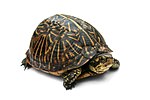Diapsids ("two arches") are a clade of sauropsids, distinguished from more primitive eureptiles by the presence of two holes, known as temporal fenestrae...
28 KB (1,776 words) - 16:45, 9 February 2025
though not diapsids in a purely anatomical sense, qualify as members of the clade Diapsida due to their likely diapsid ancestry. Some diapsids, particularly...
6 KB (609 words) - 22:22, 30 December 2024
in synapsids (mammals and their extinct relatives) there is one; and in diapsids (including birds, crocodilians, squamates, and tuataras), there are two...
46 KB (3,671 words) - 08:59, 12 February 2025
thus defining Reptilia as a more restricted crown group encompassing diapsids and parareptiles (apart from mesosaurs, which he considered to be the most...
31 KB (2,811 words) - 16:04, 27 November 2024
located higher on the skull. The function of the holes in both synapsids and diapsids was to lighten the skull and give room for the jaw muscles to move, allowing...
30 KB (3,190 words) - 23:46, 6 February 2025
ISSN 0311-5518. S2CID 131795055. Rieppel, Olivier; DeBraga, M. (1996). "Turtles as Diapsid Reptiles" (PDF). Nature. 384 (6608): 453–455. Bibcode:1996Natur.384..453R...
126 KB (13,171 words) - 00:45, 19 February 2025
found turtles to either be descendants of parareptiles, early-diverging diapsids outside of Sauria, or close relatives of lepidosaurs within the clade Ankylopoda...
12 KB (946 words) - 12:29, 14 October 2024
Sauria is the clade of diapsids containing the most recent common ancestor of Archosauria (which includes crocodilians and birds) and Lepidosauria (which...
23 KB (1,193 words) - 10:26, 7 February 2025
Kungurian or the Roadian, replaced by anomodonts, theriodonts, and the diapsid reptiles. The lifestyle of ophiacodonts has long been controversial. Some...
8 KB (550 words) - 09:48, 3 January 2025
reassignment of synapsids as non-reptiles, and classification of turtles as diapsids. Gauthier 1994 and Laurin and Reisz 1995's definition of Sauropsida defined...
139 KB (14,882 words) - 21:40, 22 February 2025
"anapsid" clade. Analysis of fossil data has shown that turtles are likely diapsid reptiles, most closely related either to the archosaurs (crocodiles, bird...
20 KB (1,491 words) - 07:35, 10 February 2025
modern paleontologists believe that the Testudines are descended from diapsid reptiles that lost their temporal fenestrae. More recent morphological...
15 KB (1,607 words) - 09:13, 26 January 2025
Hupehsuchia is an order of diapsid reptiles closely related to ichthyosaurs. The group was short-lasting, with a temporal range restricted to the late...
24 KB (2,946 words) - 03:21, 23 December 2024
studies from the late 2010s recovered them being taxonomically closer to diapsid reptiles, recent studies from the early 2020s support their traditional...
15 KB (1,513 words) - 02:09, 21 September 2024
Petrolacosaurus ("rock lake lizard") is an extinct genus of diapsid reptile from the late Carboniferous period. It was a small, 40-centimetre (16 in)...
13 KB (1,536 words) - 23:53, 21 February 2024
lizard-like gliding diapsids known from the Triassic period of Europe and North America. They are distinguished from other diapsids by their 'wings' formed...
7 KB (516 words) - 07:41, 18 November 2024
Archosauromorpha (Greek for "ruling lizard forms") is a clade of diapsid reptiles containing all reptiles more closely related to archosaurs (such as...
32 KB (3,105 words) - 14:10, 17 February 2025
Hyperodapedon, a diapsid reptile of the Triassic, c. 230 mya...
48 KB (4,002 words) - 17:33, 16 February 2025
chōristos + δέρη dérē, 'separated neck') is an extinct order of semiaquatic diapsid reptiles that ranged from the Middle Jurassic, or possibly Triassic, to...
45 KB (4,831 words) - 00:17, 11 February 2025
PhyloCode known as Pan-Lepidosauria) is a group of reptiles comprising all diapsids closer to lizards than to archosaurs (which include crocodiles and birds)...
8 KB (736 words) - 11:23, 27 September 2023
bones at the back of the skull. While all but the earliest eureptiles were diapsids, with two openings at the back of the skull, parareptiles were generally...
35 KB (2,853 words) - 20:33, 10 February 2025
the middle Permian. At first H. scholtzi was mistakenly classified as a diapsid. Members of this family were carnivorous and had dermal armor, and somewhat...
14 KB (1,799 words) - 19:26, 21 January 2025
Longisquama (category Diapsids)
from its skin. The current opinion is that Longisquama is an ambiguous diapsid and has no bearing on the origin of birds. Researchers Haubold and Buffetaut...
16 KB (1,815 words) - 17:45, 27 July 2024
Drepanosaur (section Drepanosaurs as basal diapsids)
archosauromorphs, lepidosauromorphs related to kuehneosaurids, non-saurian diapsids related to weigeltisaurids, or (most recently) basal neodiapsids. When...
24 KB (2,559 words) - 23:52, 24 July 2024
Araeoscelida is a clade of extinct tetrapods (traditionally classified as diapsid reptiles) superficially resembling lizards, extending from the Late Carboniferous...
11 KB (986 words) - 15:45, 18 January 2025
as diapsids, dinosaurs ancestrally had two pairs of Infratemporal fenestrae (openings in the skull behind the eyes), and as members of the diapsid group...
288 KB (28,552 words) - 12:13, 24 February 2025
attachment sites for jaw muscles. A similar development took place in the diapsids, which evolved two rather than one opening behind each eye. Originally...
58 KB (5,892 words) - 01:46, 17 February 2025
Benson, Roger B. J. (25 August 2021). "A reassessment of the enigmatic diapsid Paliguana whitei and the early history of Lepidosauromorpha". Proceedings...
60 KB (3,777 words) - 12:36, 17 February 2025
the Triassic Period. It is a member of the Drepanosauridae, a group of diapsid reptiles known for their prehensile tails. Drepanosaurus was probably an...
9 KB (988 words) - 18:46, 5 September 2024
aquatic or semiaquatic marine reptiles of uncertain placement within the diapsid clade. One subgroup, the thalattosauroids, are known for their unusual...
10 KB (1,062 words) - 09:41, 8 December 2024



























